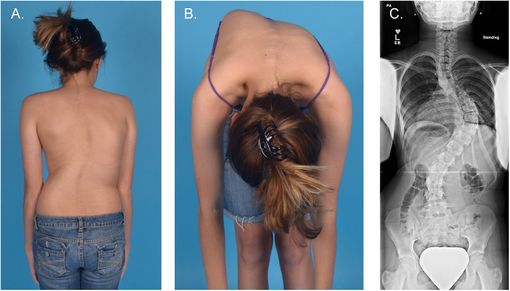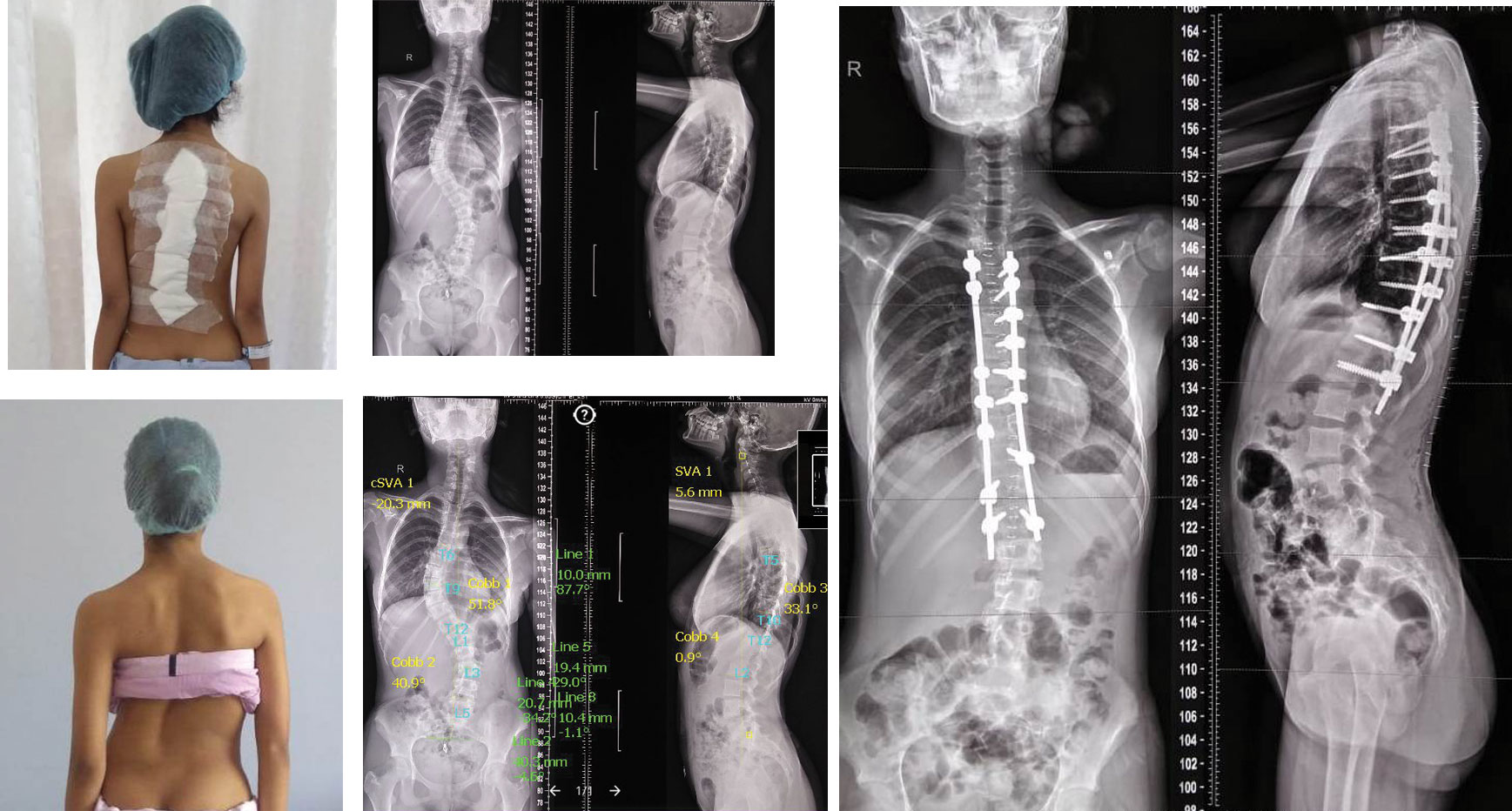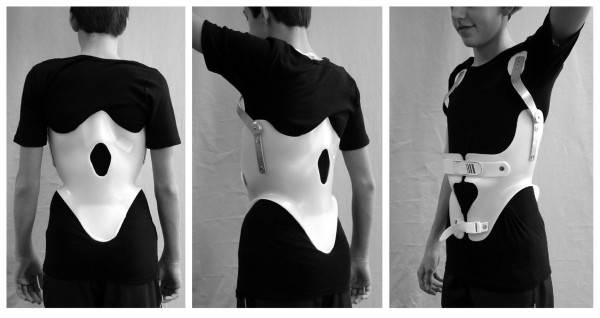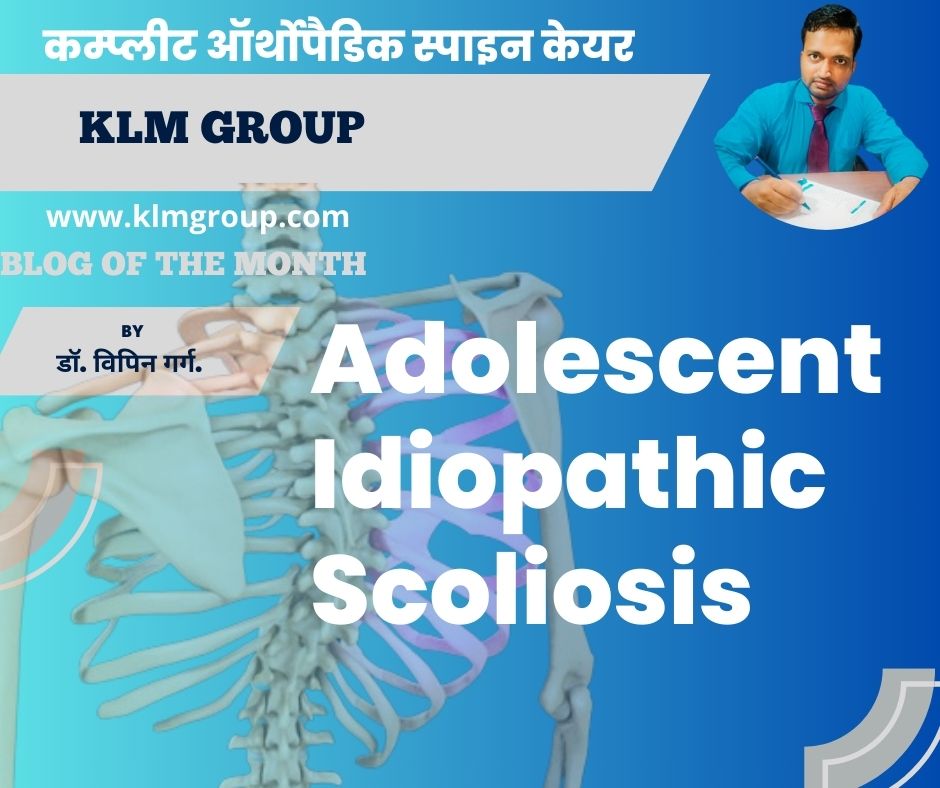Adolescent Idiopathic Scoliosis: Adolescent Idiopathic Scoliosis (AIS) is a common spinal condition that affects children and adolescents, typically between the ages of 10 and 18. It is characterized by an abnormal curvature of the spine, and its exact cause remains unknown. Early diagnosis and appropriate management are crucial to prevent the progression of the curvature and to maintain a healthy spine. This blog will explore the diagnosis, conservative management options, and the role of KLM Group and Dr. Vipin Garg in providing comprehensive care for AIS.

Understanding Adolescent Idiopathic Scoliosis
What is Adolescent Idiopathic Scoliosis?
AIS is a condition where the spine curves laterally in an “S” or “C” shape and may also rotate, causing the ribs to protrude on one side. The term “idiopathic” indicates that the cause of the condition is unknown, and it is called “adolescent” because it typically manifests during the adolescent growth spurt.

Read More:
Prevalence and Risk Factors
AIS affects approximately 2-3% of adolescents. While the exact cause is unknown, several risk factors have been identified:
- Genetics: Family history of scoliosis increases the likelihood of developing the condition.
- Gender: Females are more likely to develop severe curves that require treatment.
- Age: Rapid growth during puberty increases the risk of curve progression.
Symptoms of Adolescent Idiopathic Scoliosis
In many cases, AIS is asymptomatic and is often detected during routine school screenings or physical exams. However, some adolescents may exhibit noticeable signs, including:
- Uneven shoulders
- One shoulder blade more prominent than the other
- Uneven waist
- One hip higher than the other
- Rib prominence on one side
- Back pain (less common in mild cases)
Diagnosis of Adolescent Idiopathic Scoliosis
Physical Examination
A thorough physical examination is the first step in diagnosing AIS. During the exam, the physician will look for asymmetries in the shoulders, waist, and hips. The Adams forward bend test is commonly used, where the patient bends forward at the waist, and the examiner looks for rib prominence or other abnormalities.

Imaging Studies
If scoliosis is suspected, imaging studies are necessary to confirm the diagnosis and assess the severity of the curvature.
- X-Rays: Full-length standing X-rays of the spine are taken to measure the degree of curvature using the Cobb angle. This measurement helps classify the severity of scoliosis.
- MRI: Magnetic Resonance Imaging (MRI) may be ordered if there are neurological symptoms or if the X-rays show unusual findings. MRI provides detailed images of the spinal cord and surrounding structures.
- CT Scan: Computed Tomography (CT) scans may be used in certain cases to provide more detailed images of the spine.
Scoliosis Classification
AIS is classified based on the degree of curvature and the location of the curve:
- Mild Scoliosis: Cobb angle less than 20 degrees
- Moderate Scoliosis: Cobb angle between 20 and 40 degrees
- Severe Scoliosis: Cobb angle greater than 40 degrees
The location of the curve is also noted, such as thoracic, lumbar, or thoracolumbar.
Conservative Management of Adolescent Idiopathic Scoliosis
While surgical intervention may be necessary for severe cases, most adolescents with AIS can be managed conservatively. The goals of conservative treatment are to prevent curve progression, improve posture, and maintain overall spine health.
Observation
For mild scoliosis (Cobb angle less than 20 degrees), regular monitoring is usually recommended. Observation involves:
- Regular Check-Ups: Periodic physical exams and X-rays to monitor curve progression.
- Growth Monitoring: Since scoliosis progression is linked to growth spurts, monitoring growth patterns is essential.
Bracing
Bracing is the most common non-surgical treatment for moderate scoliosis (Cobb angle between 20 and 40 degrees). Bracing aims to prevent further curve progression during the growth period.
- Types of Braces: Several types of braces are available, including the Boston brace, the Wilmington brace, and the Milwaukee brace. The choice of brace depends on the curve pattern and the patient’s needs.
- Wearing Schedule: Braces are typically worn for 16-23 hours a day, depending on the severity of the curve and the stage of growth.
- Effectiveness: Bracing can be highly effective in preventing curve progression, especially if worn as prescribed.

Physical Therapy
Physical therapy plays a crucial role in managing AIS by improving muscle strength, flexibility, and posture. A tailored exercise program can help maintain spinal alignment and reduce discomfort.
- Schroth Method: This specialized physical therapy approach focuses on scoliosis-specific exercises to correct posture, improve muscle symmetry, and enhance breathing patterns.
- Core Strengthening: Exercises to strengthen the core muscles can provide better support for the spine and reduce the risk of progression.
- Postural Training: Training to improve posture and body mechanics can help manage scoliosis symptoms and improve quality of life.
Chiropractic Care
Chiropractic care involves spinal adjustments and manipulations to improve alignment and reduce pain. While not a primary treatment for scoliosis, it can be used as an adjunct to other conservative treatments.
- Spinal Adjustments: Gentle adjustments to realign the spine and improve function.
- Muscle Release Techniques: Techniques to release muscle tension and improve flexibility.
- Pain Management: Chiropractic care can help manage pain and discomfort associated with scoliosis.
Lifestyle Modifications
Adopting a healthy lifestyle can support overall spine health and complement other conservative treatments.
- Exercise: Regular physical activity, including low-impact exercises like swimming and walking, can improve overall fitness and spine health.
- Healthy Diet: A balanced diet rich in calcium and vitamin D supports bone health.
- Proper Ergonomics: Maintaining good posture and using ergonomic furniture can reduce strain on the spine.

Expert Care at KLM Group
The KLM Group, led by Dr. Vipin Garg, offers comprehensive care for adolescents with idiopathic scoliosis. Their multidisciplinary approach ensures that patients receive individualized treatment plans tailored to their specific needs.
Services Provided by KLM Group
Scoliosis Screening: Routine screening to detect scoliosis early and monitor curve progression.
Diagnostic Imaging: State-of-the-art imaging techniques to accurately diagnose and classify scoliosis.
Bracing: Custom-fitted braces designed to prevent curve progression and improve spinal alignment.
Physical Therapy: Specialized physical therapy programs, including the Schroth method, to strengthen muscles and improve posture.
Chiropractic Care: Gentle spinal adjustments and muscle release techniques to support overall spine health.
Patient Education: Guidance on lifestyle modifications, proper ergonomics, and exercises to maintain spine health.
Comprehensive Evaluations: Detailed assessments to create personalized treatment plans.
Dr. Vipin Garg
Dr. Vipin Garg is a renowned orthopedic specialist with extensive experience in diagnosing and treating spinal conditions, including adolescent idiopathic scoliosis. His expertise ensures that patients receive the highest quality care tailored to their specific needs. Dr. Garg’s holistic approach to scoliosis management includes a combination of conservative treatments to achieve the best possible outcomes.
Conclusion
Adolescent Idiopathic Scoliosis is a common spinal condition that can significantly impact an adolescent’s life. Early diagnosis and appropriate conservative management are crucial to prevent curve progression and maintain a healthy spine. Observation, bracing, physical therapy, chiropractic care, and lifestyle modifications are effective conservative treatment options that can help manage AIS and improve quality of life.
The KLM Group, led by Dr. Vipin Garg, provides expert care for adolescents with scoliosis. Their multidisciplinary approach ensures that patients receive comprehensive and individualized treatment plans to achieve the best possible outcomes. With the right care and support, adolescents with scoliosis can lead active, healthy lives.
Contact KLM Group:
- Book Your Consultation
- Website: https://tinyurl.com/yyzvwmck
- Email: info@klmgrou p.org
- Ph: 0751-4000721,Mob: 7804826825
- Address: 12, Saraswati Nagar, University Road, Near Silver Estate, Thatipur,
- Address Link: https://g.page/r/CQ0WqKLEXPWeEAE Powered By Argusdna Also for the best, Orthopedic doctor and surgeon in Kolkata visit www.bonedoctorgautam.com
Take the first step towards better spine health by consulting with the experts at KLM Group. Their dedicated team is here to help you achieve your health goals and improve your quality of life.

